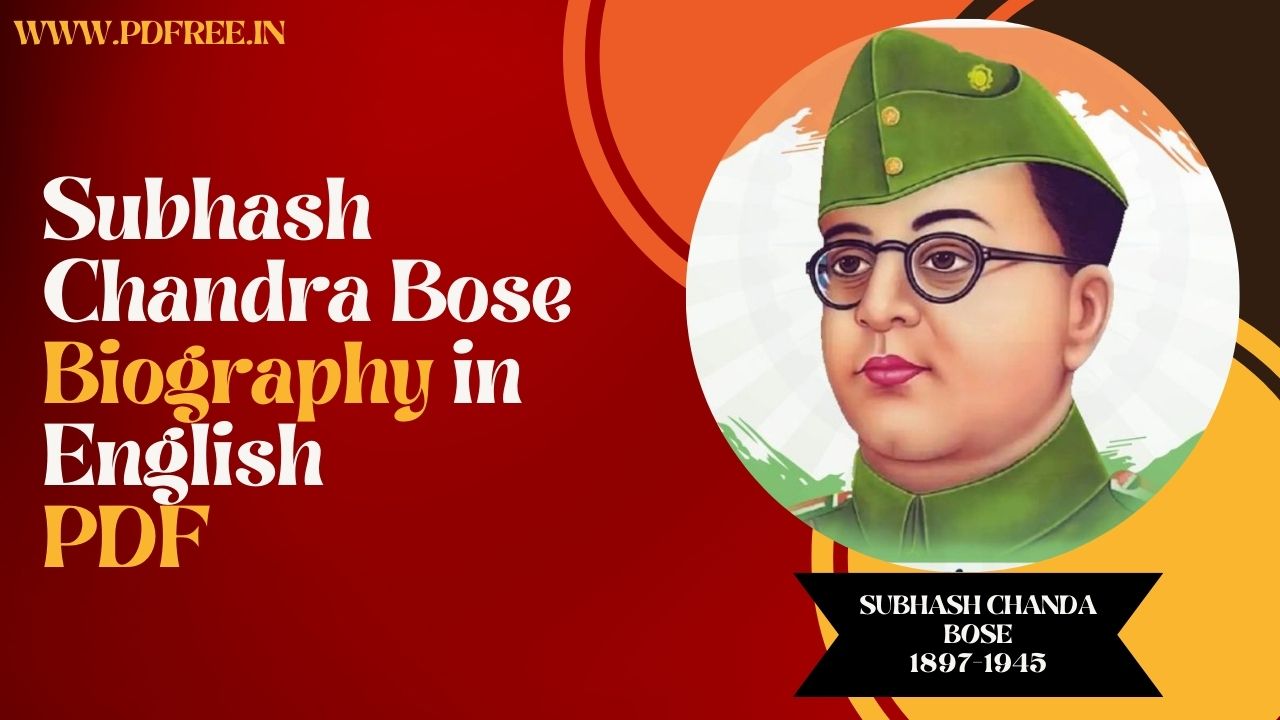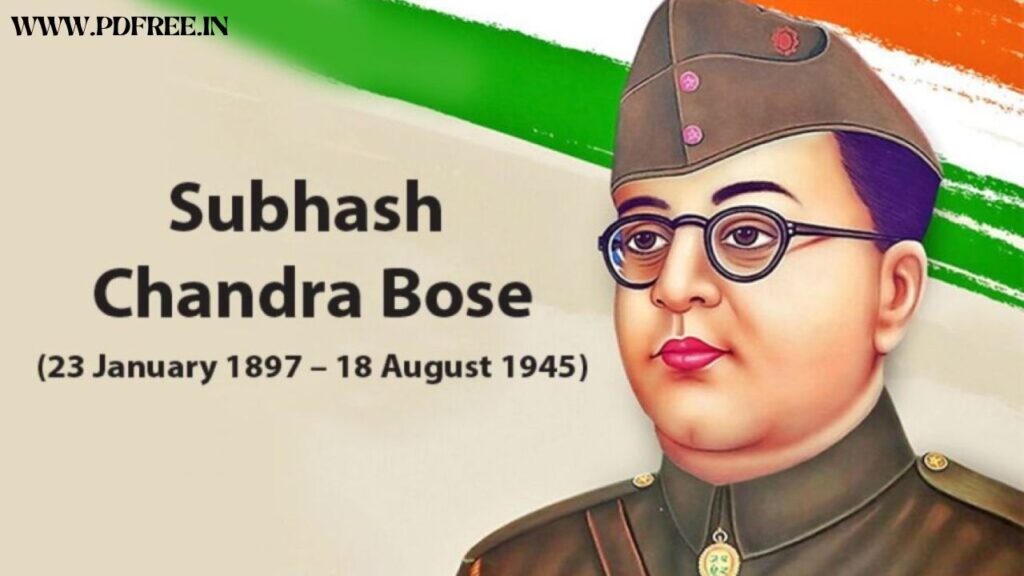In this Article, Subhash Chandra Bose Biography in English pdf, include that a charismatic leader in the fight for India’s freedom left an indelible mark on history. In this detailed biography available in English PDF, we delve into the various facets of his life, showcasing the man behind the legend.

Subhash Chandra Bose, a charismatic leader in the fight for India’s freedom, left an indelible mark on history. In this detailed biography available in English PDF, we delve into the various facets of his life, showcasing the man behind the legend.
Table of Contents
Subhash Chandra Bose Biography in English pdf Details:
| Pdf File | Subhash Chandra Bose Biography in English pdf |
| Size | 564 KB |
| Pages | 150 |
| Credit | www.hindustanbook.com |
| Cost | Free |
| Last Update | 20 Nov 2023 |
| Language | English |
Subhash Chandra Bose Biography in English pdf

Early Life and Political Awakening
Born into a prosperous Bengali family, Bose began his education at Presidency College, Calcutta (Kolkata). However, his expulsion in 1916, due to his involvement in nationalist activities, marked the start of his sincere dedication to the cause. He continued his studies at the Scottish Churches College, graduating in 1919.
Bose’s parents sent him to the University of Cambridge in England to prepare for the Indian Civil Service. Despite passing the civil service examination in 1920, news of nationalist unrest in India prompted him to abandon his candidacy in April 1921. He swiftly returned to India, driven by the unfolding events.
Sarat Chandra Bose (1889-1950), a wealthy lawyer in Calcutta and a well-known leader of the Indian National Congress, popularly known as the Congress Party, provided Bose with both material and emotional support during his career, especially in its early stages.
Political life of Subhas Chandra Bose and Mahatma Gandhi
The Indian National Congress began to support and like Gandhi more at this time. Gandhi thereby gained more clout within the party. The civil disobedience movement, meantime, got underway in 1930. Nevertheless, at that time Subhas Chandra Bose, who belonged to the Bengal Volunteers, an underground revolutionary organization, was already detained.
Despite being in prison, Bose was elected as the mayor of Calcutta. He faced multiple arrests for his suspected involvement in violent activities. Eventually, he was allowed to travel to Europe due to contracting tuberculosis, which led to his release for health reasons. While in enforced exile and still unwell, Bose authored “The Indian Struggle, 1920–1934” and advocated for India’s cause with European leaders.
Read More:
Swami Vivekananda Biography in English Pdf free Download
The Inspiring Journey of Dr. APJ Abdul Kalam Biography in English
Upon his return from Europe in 1936, Bose found himself in custody once more. It wasn’t until a year later that he was finally released. This period underscores the intricate and turbulent political dynamics within the Indian National Congress and the broader struggle for India’s independence in the early 1930s.
In the meantime, Bose began to grow more disapproving of Gandhi’s less combative strategy for independence and his conservative economic beliefs. Upon assuming the presidency of the Indian National Congress in 1938, Bose established a national planning committee with the objective of achieving extensive industrialization. Gandhi’s economic theories, on the other hand, supported small-scale companies and the use of domestic resources.
Bose’s validation came in 1939 when he beat a candidate for re-election who ran on Gandhian ideas. In spite of this triumph, the “rebel president” felt forced to step down because of Gandhi’s lack of backing. Subsequently, he established the Forward Bloc with the aim of garnering backing from more extreme factions. But in July 1940, he was sent to prison once more.
During this crucial time in India’s history, Bose refused to stay in prison and threatened to go on a hunger strike until death. This bold move pressured the British government to release him. On January 26, 1941, closely monitored, he escaped from his residence in Calcutta in disguise. He traveled through Kabul and Moscow, eventually reaching Germany in April.
Subhas Chandra Bose and the Indian National Army in World War II
In Nazi Germany, Bose became associated with a recently established Special Bureau for India, overseen by Adam von Trott zu Solz. Alongside other Indians gathered in Berlin, he regularly broadcasted on the German-sponsored Azad Hind Radio starting in January 1942. These broadcasts were delivered in English, Hindi, Bengali, Tamil, Telugu, Gujarati, and Pashto.
Bose left Germany just over a year following the Japanese invasion of Southeast Asia. His journey involved travel by German and Japanese submarines and planes, ultimately bringing him to Tokyo in May 1943. On July 4, he assumed leadership of the Indian Independence Movement in East Asia and, with Japanese assistance and influence, organized a trained army of approximately 40,000 troops in Japanese-occupied Southeast Asia.
The Indian National Army, also known as Azad Hind Fauj, proceeded alongside Japanese forces to Rangoon (Yangon) and then crossed overland into India when Bose proclaimed the beginning of a temporarily independent Indian government on October 21, 1943. Arriving in Kohima and the Imphal plains, they entered Indian territory on March 18, 1944. The Japanese and Indian soldiers were forced to flee after a fierce engagement without any support from Japanese aircraft. However, the Indian National Army persisted in its role as a liberation army, maintaining its identity for a while, initially in Indochina and then in Burma.
Conclusion
In conclusion, the early chapters of Subhash Chandra Bose biography in English PDF unveil his unwavering commitment to India’s struggle for independence. From his expulsion from nationalist activities to his pivotal role in the noncooperation movement led by Mohandas K. Gandhi, Bose’s journey is marked by dedication and resilience. Despite facing imprisonment and deportation, Bose’s leadership shines through. His return to Bengal, his election as the president of the Bengal Congress, and his role as a general secretary of the Indian National Congress highlight his prominence in the political landscape. Aligned with Jawaharlal Nehru, Bose’s assertive stance within Congress sets the stage for the next chapters in this remarkable exploration of Subhash Chandra Bose’s life.
FAQs
Q 1. Who was Subhas Chandra Bose?
Ans: Subhas Chandra Bose was a prominent figure in the Indian independence movement during the early to mid-20th century.
Q 2. What role did Bose play in the Indian National Congress?
Ans: Bose became a key figure within the Indian National Congress, leading the party and advocating for independence. However, differences with Gandhi led to notable developments.
Q 3. Why did Bose leave Germany during World War II?
Ans: Bose departed Germany a little over a year after the Japanese invasion of Southeast Asia, marking a critical shift in his efforts during World War II.